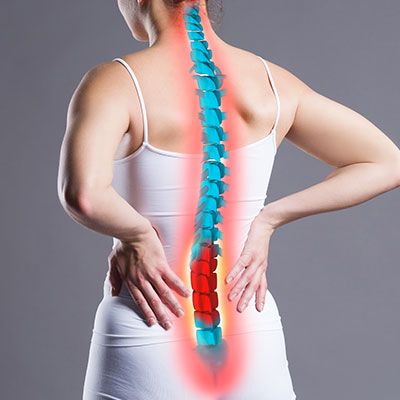Ankylosing Spondylitis
Home
Ankylosing Spondylitis
Ankylosing Spondylitis Treatment & Management – Symptoms, Specialists & Exercises
What is Ankylosing Spondylitis?
Ankylosing Spondylitis is a chronic, progressive type of arthritis that mainly affects the spine and sacroiliac joints (where the spine connects to the pelvis). The condition causes inflammation of spinal joints, resulting in pain, stiffness, and limited flexibility. Over time, this inflammation can lead to fusion of vertebrae (ankylosis), creating a rigid or hunched posture.
AS belongs to the group of rheumatic diseases called spondyloarthropathies, which also include conditions like psoriatic arthritis and reactive arthritis. It is strongly associated with the HLA-B27 gene, although not everyone with this gene develops the disease.
Unlike temporary back pain, AS is systemic and lifelong, requiring long-term treatment and management strategies.

Causes of Ankylosing Spondylitis
The exact cause of AS is still not fully known, but researchers believe a combination of genetic, immune, and environmental factors play a role.
Genetic Factors
- AS has a strong hereditary link.
- Around 90% of patients with AS carry the HLA-B27 gene.
- Having a family history of AS significantly increases the risk.
Immune System Dysfunction
- In AS, the immune system mistakenly attacks healthy joints and tissues.
- This leads to chronic inflammation in the spine and sacroiliac joints.
Environmental Triggers
- Certain infections or external factors may trigger AS in genetically predisposed people.
- Lifestyle issues like smoking or poor posture can worsen disease progression.
Symptoms of Ankylosing Spondylitis
The symptoms of AS usually start gradually and worsen over time. Early recognition is crucial for effective treatment.
Common Symptoms:
- Persistent lower back pain and stiffness, often worse in the morning or after inactivity.
- Hip and buttock pain that may alternate between sides.
- Limited spinal flexibility and difficulty bending or twisting.
- Shoulder, rib, or heel pain due to inflammation in joints beyond the spine.
- Fatigue, sleep disturbances, and reduced energy levels due to chronic pain.
Advanced Symptoms:
- Fusion of vertebrae, leading to loss of spinal mobility and a stooped posture.
- Chest pain and restricted breathing caused by limited rib movement.
- Eye inflammation (uveitis) resulting in redness, blurred vision, or sensitivity to light.
- In rare cases, complications involving the heart, lungs, or kidneys.
Stages of Ankylosing Spondylitis
AS develops in stages, and progression differs for each individual:
Stage 1: Early Stage
- Mild stiffness and intermittent back pain.
- Often mistaken for common backache or posture issues.
Stage 2: Progressive Stage
- Persistent pain and stiffness in the spine and hips.
- Reduced flexibility affecting daily activities.
Stage 3: Advanced Stage
- Visible spinal curvature (kyphosis).
- Restricted chest expansion, making breathing difficult.
Stage 4: Severe/Chronic Stage
- Spinal fusion (ankylosis) leading to disability.
Associated complications like psoriatic arthritis or inflammatory bowel disease.
Specialists for Ankylosing Spondylitis
AS management requires a multidisciplinary approach:
- Rheumatologist – Primary doctor for diagnosis, medication, and long-term management.
- Physiotherapist – Designs personalized exercise routines to improve flexibility and posture.
- Orthopedic Specialist – Handles skeletal deformities and surgical interventions if needed.
- Ophthalmologist – Manages eye complications such as uveitis.
- Dietitian/Nutritionist – Helps create an anti-inflammatory diet plan.
- Psychologist or Counselor – Assists with emotional and mental well-being, since chronic illness can impact mental health.
Treatment & Management of Ankylosing Spondylitis
Currently, there is no permanent cure for AS. However, with early diagnosis, proper medication, physiotherapy, and lifestyle adjustments, symptoms can be controlled, and progression can be slowed.
1. Medications
- NSAIDs (Non-Steroidal Anti-Inflammatory Drugs): Relieve pain and inflammation.
- DMARDs (Disease-Modifying Anti-Rheumatic Drugs): Effective for non-spinal joints.
- Biologics (TNF inhibitors, IL-17 blockers): Target specific immune responses, significantly reducing inflammation.
- Corticosteroid Injections: Provide temporary relief for inflamed joints.
2. Physiotherapy & Exercises
Regular exercise is the cornerstone of AS management. It helps maintain flexibility, reduce stiffness, and prevent spinal deformity.
- Stretching Exercises: Improve flexibility in the spine and hips.
- Strength Training: Supports muscles around joints, reducing stress.
- Breathing Exercises: Enhance lung capacity and rib mobility.
- Posture Training: Prevents forward spinal curvature.
3. Lifestyle & Home Remedies
- Maintain a regular exercise routine to keep joints flexible.
- Ensure adequate rest and sleep for tissue repair.
- Use heat therapy (warm baths, heating pads) to relax stiff muscles.
- Quit smoking and excessive alcohol consumption, which worsen symptoms.
- Practice stress management techniques like yoga, meditation, and mindfulness.
4. Surgical Interventions
In rare, advanced cases where deformity or mobility issues are severe, surgical correction or joint replacement may be recommended.
Benefits of Early & Holistic Management
- Reduces chronic pain and stiffness.
- Prevents or delays spinal deformity.
- Improves posture and flexibility.
- Enhances lung and heart health.
- Supports emotional and mental well-being.
FAQ
No, but with proper treatment and lifestyle management, symptoms can be controlled and disease progression slowed.
A rheumatologist is the primary doctor for diagnosis and management.
Yes, in fact, exercise is essential to maintain flexibility, reduce stiffness, and prevent spinal fusion.
Stretching, yoga, swimming, and breathing exercises are highly recommended.
Yes. An anti-inflammatory diet supports better joint health and reduces flare-ups.
